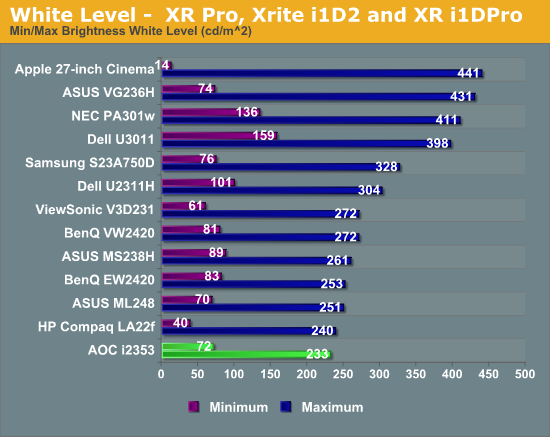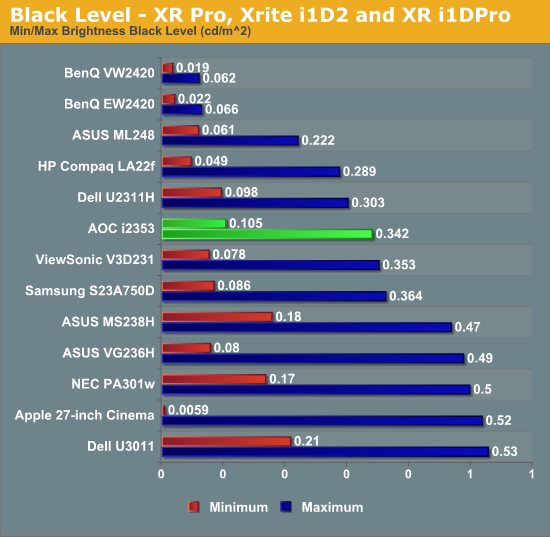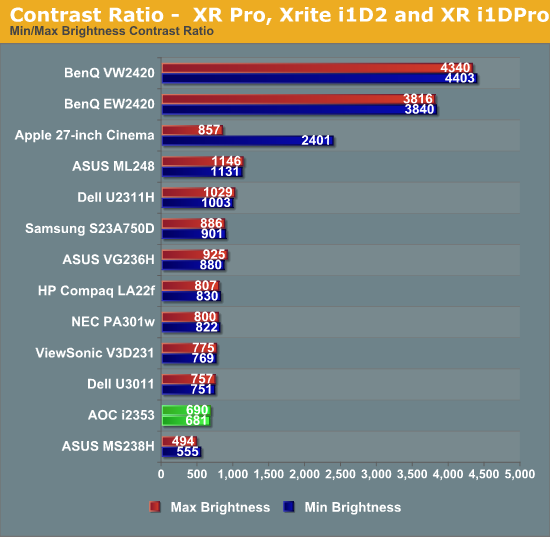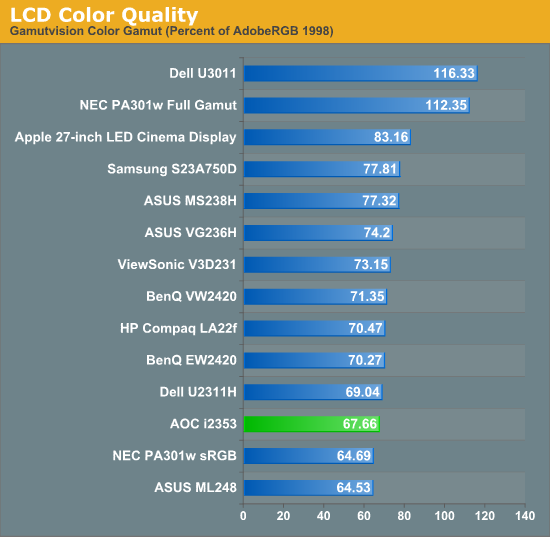AOC i2353Ph - IPS for a nice, low price
by Chris Heinonen on January 30, 2012 12:40 AM ESTPeak Levels, Contrast, and Color Gamut
The brightness uniformity of the AOC was overall good, but just how bright can the AOC go? With it set to user mode, and the backlight raised all the way up, I only managed to get 233 nits out of the display with a solid white screen. Since it is a matte surface and not glossy, reflections should not be a big issue and this level of light should be more than enough for most people. Unless you have direct sunlight on your display I don’t think most people would need more light output than it provides.
Turning the backlight all the way down left us with 72 nits of light output, which lets us know we can turn the display down enough for print work, or a completely dark environment, without having an image that is too bright for what we are working on.

After the black uniformity tests, I was a little bit worried about what the minimum black levels would be, and it looks like I was correct on that. With the backlight set to maximum, and pure black screen gave us 0.342 nits of light, which is pretty bright for a black screen. Lowering the backlight all the way down to minimum took the black level down to 0.105 nits, which is still high. This is similar to the last eIPS display that came past my desk (The Dell U2311H), and we discussed that black levels are an area that IPS still needs to work on. For comparison, the recent VA panels from BenQ with an LED backlight have a black level at maximum brightness, 0.066 nits, that is still far lower than the AOC can put out with the backlight level at minimum. If deep, rich black is important to you, you probably will want to look at an option other than the AOC, or even IPS altogether.

Once I saw the black levels, I had a feeling that the contrast levels were going to leave something to be desired. Looking at what the AOC can produce, we can’t quite hit 700:1 for the contrast ratio with the backlight at high or low power. This isn’t really surprising given the price point of the AOC, and the use of an IPS panel.

As we discussed in the calibrated results section, the color gamut on the AOC is a bit smaller than the sRGB colorspace. When we measure against the AdobeRGB colorspace, we expect to see a monitor be able to reproduce around 71% of that if it is sRGB capable, but with the AOC we only saw 67.7% coverage. This is what is leading to the larger average dE error, as it can’t produce some of the colors we are looking for, but it still has a lower median dE since it does a good job with the colors it can produce.











71 Comments
View All Comments
cheinonen - Monday, January 30, 2012 - link
Not sure why that chart imported incorrectly, but it has been fixed. Thanks!baba264 - Monday, January 30, 2012 - link
I've recently changed to an IPS panel as well (HP ZR2440w) and the difference in gaming image quality has been impressive, especially in Batman Arkham City.jabber - Monday, January 30, 2012 - link
As I wanted to see how the new low cost IPS panels fared. I have to say I really like it. Looks as good as if not better than my Samsung PVA panel and as a work monitor its really good.Calibration was pretty much spot on out of the box. All I had to do was turn down the brightness a bit.
Definitely a nicer alternative at the cheaper end over TN.
Pino - Monday, January 30, 2012 - link
Who is the panel supplier?Does this AOC monitor use the same LG e-IPS panel found on the Dell and LG 23" e-IPS monitors?
Just bought myself a LG IPS236V:
http://www.lg.com/us/computer-products/monitors/LG...
Sabresiberian - Monday, January 30, 2012 - link
Panel manufacturer is LG:http://www.tftcentral.co.uk/panelsearch.htm
;)
Sabresiberian - Monday, January 30, 2012 - link
Bleh the link just goes to the search page. If you put in "AOC" it will list the models with the screen manufacturer and type TFT has available.;)
bobny1 - Friday, March 23, 2012 - link
Aoc is a long time supplier of lcd displays. I remember when they started selling their name brand monitors at staples. I just went out and bought one today to replace my dell 2005 lcd, which could not play blueray movies out of my new dell xps8300, due to hdcp compliance. My first impresion is WOW. This panel is amazing!. bright, crisp, accurate colors, easy on the eyes, no lagg, no back light bleeding that i can see, deep enough blacks, superb viewing angles, I can't tell about games because that's not my primary use but what else can you get for under $200 bucks. I compare it to the LG e-ips in the store hooked up to the same xps8300 and the AOC is a lot better in my opinion.I have it hooked up hdmi to hdmi and the adjustments are limited but all i had to do was lower the contrast a bit and stretch the screen to fit the screen in the catlyst control center. I love it!SInC26 - Sunday, April 22, 2012 - link
This AOC monitor uses the LG's e-IPS LM230WF3-SJC1.AOC does manufacture some of their own panels, but not for this monitor.
Mikuni - Monday, January 30, 2012 - link
I don't like this trend lately with 23" 1080p LCDs, it's a long way backwards from 1920x1200; the vertical size difference is a lot for most desktop use.kmmatney - Monday, January 30, 2012 - link
I agree. I have both a 24" 1920 x 1200 and a 23" NEC eIPS 1080P monitor next to each other The 24" inch monitor is better for everything. Maybe movies are slightly better at 1080P, but it's really only a small improvement. Everything else is better with more vertical screen space. While 1080p isn't terrible, its still a step backwards. There are still a few 1920 x 120 displays out there, and I will stick with those for now.